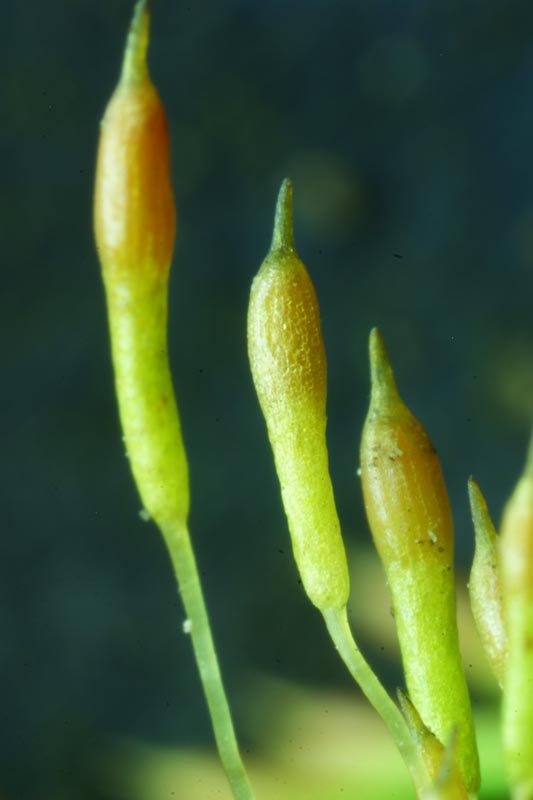Bruchia Schwägrichen, 1824.

Bruchia bolanderi, photo by Steve Matson
NEEDS GENUS PARAGRAPH
Key to Bruchia Etc.
The plants included in this key are tiny acrocarpous mosses with narrowly acuminate to subulate leaves. They may have capsules immersed or nearly so, or the capsule may be exserted and have elongate hypophyses. Some are winter-growing ephemeral mosses of lowland grassy or barren areas; others (Trematodon boasii and Bruchia bolanderi) are summer-growing ephemerals of alpine or high montane meadows with capsules appearing late in the summer.
Species included in this key are in Bruchiaceae, except Pleuridium (Ditrichaceae):
Bruchia bolanderi Lesquereux
Bruchia flexuosa (Swartz ex Schwägrichen) C. Müller Hal.
Pleuridium acuminatum Lindberg
Pleuridium subulatum (Hedwig) Rabenhorst
Trematodon boasii W. B. Schofield
None of the species included here is likely to be collected unless one sees them with sporophytes. Gametophytic plants would most likely be interpreted as small Ditrichum, and these will be difficult to identify. The hyaloderm of Archidium differs from the stem cross-sectional features of any Ditrichum. The short awn of Trematodon is filled by the costa to a degree different from that of any Ditrichum. The high elevation habitat of both Bruchia bolanderi and Trematodon boasii does not overlap that of any California Ditrichum.
A. Leaves with a long subulate awn completely filled by the costa .....B
A. Leaves with awn not filled by the costa .....C
B. Awn comprising less than 1/4 of leaf; capsule exserted on a straight seta with the urn subtended by a long hypophysis; capsule peristomate with a well-differentiated operculum, dehiscing at maturity; calyptra cucullate; plant of alpine and subalpine sites .....Trematodon: T. boasii
B. Awn relatively longer; capsule barely emergent and without a long hypophysis; capsule cleistocarpous without a peristome; calyptra mitrate; plant of low elevation grasslands .....Bruchia flexuosa
C. Plant of alpine and subalpine sites; leaves mostly less than 8:1; median cells of leaves mostly more than 8 µm broad; capsule long exserted above the perichaetial leaves; hypophysis as long as the urn .....Bruchia bolanderi
C. Plant of low elevation grassy and barren sites; leaves subulate and longer than 8:1; median cells of leaves more narrow; capsule immersed on a somewhat curved seta; hypophysis not much differentiated .....D
D. Lamina unistratose at shoulder of upper laminal and perichaetial leaves; plants autoicous, antheridia enclosed in axillary buds .....Pleuridium: P. subulatum
D. Lamina bistratose at shoulder of upper laminal and perichaetial leaves; plants paroicous, antheridia naked in the axils of upper stem leaves .....Pleuridium: P. acuminatum

